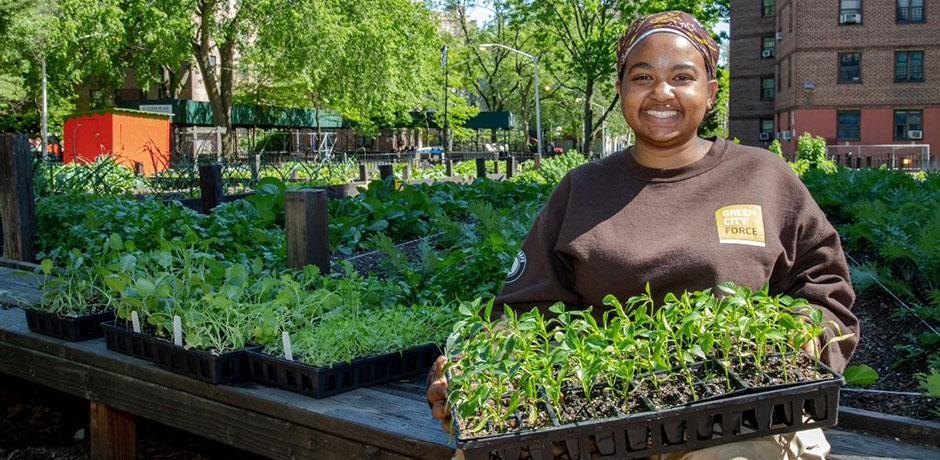A Biased View of City Blooming
A Biased View of City Blooming
Blog Article
Our City Blooming PDFs
Table of ContentsCity Blooming Can Be Fun For EveryoneTop Guidelines Of City BloomingA Biased View of City BloomingIndicators on City Blooming You Should KnowThe Basic Principles Of City Blooming
Interested in expanding food for sale in the City of Chicago? Below is a list of often asked inquiries concerning the guidelines and policies that farmers must think about when planning a metropolitan farming job.
The zoning change does not change any other codes handling composting, structure licenses, acquiring or renting City had residential or commercial property, business licenses or environmental contamination. There are existing codes that regulate these problems and they remain completely effect and might apply to your task. Area gardens are typically had or taken care of by public entities, public organizations or community-based companies and kept by volunteers.
Urban ranches grow food that is meant to be offered, either on a not-for-profit or for-profit basis. Due to their business function, city ranches call for a service license.
8 Simple Techniques For City Blooming
Composting is permitted yet just for plant material that is produced and utilized on website. The amount of compost material can not exceed 25 cubic backyards at any offered time according to the requirements in 7-28-715 of the City's Municipal Code. Yes. Because the dirt at most brand-new garden websites needs modifying, compost, dirt, timber chips, or various other materials can be acquired to build or enhance the expanding area - City gardening.

If a building authorization is needed then the hoophouse will be thought about an accessory structure. You can figure out more concerning the building license requirements by calling the Division of Buildings. The 25,000-square-foot size restriction is meant to avoid a solitary neighborhood garden from dominating an offered block or interfering with the block's existing household or business personality.
The limitation does not use to gardens situated in Public Open Area (POS) areas. Can there be more than one neighborhood yard that is 25,000 square feet on a single block? Fencing is not needed, nonetheless, yards that have large vehicle parking locations may be needed to mount fence or various other landscape design attributes.
City Blooming Fundamentals Explained
B1 & B2 districts need that all commercial usage tasks be conducted inside. R areas restrict industrial activity. The laws reflect the function and intent of the Zoning Code. Is fence needed for metropolitan ranches? Yes. Fencings linked here may be needed, in addition to landscape design and screening, for certain car parking areas and outdoor work or storage areas relying on place and the details task taking place.
Yes. Urban ranches need building authorizations and zoning authorizations before building. Other forms of city evaluation may be required depending on specific structures, activities, dimension, landscaping, licensing, public heath and stormwater management concerns. Much of these needs are identified in the job style or allowing procedure, nevertheless, the applicant might be liable to separately determine particular licenses or permits that might be called for.
The Department of Service Matters and Consumer Security can help determine the particular type of organization license that's needed. Off road car park is required for a lot of commercial tasks in Chicago. The called for number of auto parking rooms is based on the number of employees working on site and not the square video footage of the expanding room.
Some Of City Blooming

Yes. A city ranch can offer compost material produced on site, nonetheless, the procedure needs to follow the regulations in 7-28-715 of the Chicago Municipal Code. Yes. Aquaponic systems are permitted indoors on metropolitan ranches in several zoning districts. A zoning testimonial and building license is called for in order to set up frameworks or systems and an organization permit is needed as explained above.
Up to 5 hives or swarms of honey might be maintained as an accessory use. Nonetheless, beekeepers need to sign up with the Illinois Division of Agriculture. For additional information regarding the suggested zoning amendment you might contact the Department of Housing and Economic Development, Bureau of Planning and Zoning at 312.744.8563.
, which takes place in rural areas at the side of suburban areas.
Some Ideas on City Blooming You Should Know
It can include an activity of natural cultivators, "foodies" and "locavores", that look for to create social media networks based on a shared principles of nature and neighborhood holism. These networks can develop using formal institutional assistance, ending up being integrated right into regional town planning as a "transition town" movement for lasting city advancement.
The extra direct accessibility to fresh veggie, fruit, and meat items that might be realised through metropolitan farming can boost food security and food security while lowering food miles, leading to lower greenhouse gas discharges, consequently adding to environment change mitigation. Several of the very first evidence of city farming originates from Mesopotamia.
Report this page